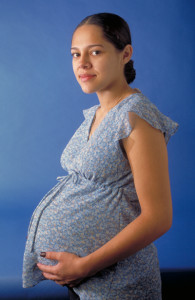3.6: Teratogens
- Last updated
- Nov 19, 2023
- Save as PDF
- Page ID
- 69367
( \newcommand{\kernel}{\mathrm{null}\,}\)
A look at some teratogens
One of the most commonly used teratogens is alcohol and because half of all pregnancies in the United States are unplanned, it is recommended that women of child-bearing age take great caution against drinking alcohol when not using birth control or when pregnant (Surgeon General’s Advisory on Alcohol Use During Pregnancy, 2005). Alcohol consumption, particularly during the second month of prenatal development but at any point during pregnancy may lead to neurocognitive and behavioral difficulties that can last a lifetime. Binge drinking (5 or more on a single occasion) or 7 or more drinks during a single week place a child at risk. In extreme cases, alcohol consumption can lead to fetal death but more frequently it can result in fetal alcohol spectrum disorders (FASD). FASD is the terminology that is now used when looking at the effects of exposure and replaces the term fetal alcohol syndrome (FAS), although you may see the two terms used interchangeably. FASD is preferred because it recognizes that symptoms occur on a spectrum and that all individuals are not equally impacted. Children with FASD share certain physical features such as flattened noses, small eye holes, and small heads, intellectual developmental delay, and behavioral problems. Those with FASD are more at risk for lifelong problems such as criminal behavior, psychiatric problems, and unemployment (CDC, 2006). The terms alcohol-related neurological disorder (ARND) and alcohol-related birth defects (ARBD) have replaced the term Fetal Alcohol Effects to refer to those with less extreme symptoms of FASD. ARBD include kidney, bone and heart problems.

Tobacco is the second most widely used teratogen and the number of adolescent females who smoke is increasing. In fact, among adolescents, females are just as likely to smoke as are males. Tobacco use during pregnancy has been associated with low birth weight, placenta previa, preterm delivery, fetal growth restriction and sudden infant death syndrome (Center for Disease Control, 2004).
Illicit drugs as well as prescribed medications can have serious teratogenic effects. It is difficult to completely determine the effects of a particular illicit drug on a developing child because most mothers, who use, use more than one substance. However, several problems seem clear. The use of cocaine is connected with low birth weight, stillbirths and spontaneous abortion. Heavy marijuana use is associated with brain damage and ADHD and mothers addicted to heroin often pass that addiction to their child. And many medications do not include adequate information on risks posed if taken during pregnancy (Center for Disease Control, 2004).
Pollutants
Some environmental pollutants of major concern include lead poisoning, which is connected with low birth weight and slowed neurological development. Children who live in older housing in which lead based paints have been used have been known to eat peeling paint chips thus being exposed to lead. The chemicals in certain herbicides are also potentially damaging. Radiation is another environmental hazard. If a mother is exposed to radiation, particularly during the first 3 months of pregnancy, the child may suffer some congenital deformities. There is also an increased risk of miscarriage and stillbirth. Mercury leads to physical deformities and intellectual development delay (Dietrich, 1999).
HIV
One of the most potentially devastating teratogens is HIV. It is estimated that between 630,000 to 820,000 children were newly infected with HIV worldwide in 2005. Most of this infection is from mother-to-child through the placenta or birth canal (Newell, 2005). Fortunately, there are measures that can be taken to lower the chance the child will contract the disease (such as the use of antiretroviral drugs from 14 weeks after conception until birth, avoiding breastfeeding, and delivering the child by c-section). Unfortunately, some women do not know they are HIV positive during pregnancy and others cannot afford the costly drugs used for treating AIDS. The transmission rate of HIV from mother to child has been reduced in the United States to between 100-200 infants annually.
Maternal Diseases
German measles (or rubella) have been associated with a number of maladies. If the mother contracts the disease during the first three months of pregnancy, damage can occur in the eyes, ears, heart or brain of the unborn child. Deafness is almost certain if the mother has German measles before the 11th week of prenatal development and can also cause brain damage. Gonorrhea, syphilis, and Chlamydia are sexually transmitted infections that can be passed to the fetus by an infected mother; mothers should be tested as early as possible to minimize the risk of spreading these infections (Center for Disease Control, 2006).
Pregnancy
Complications of Pregnancy

Minor complications: There are a number of common side effects of pregnancy. Not everyone experiences all of these nor to the same degree. And although they are considered “minor” this is not to say that these problems are potentially very uncomfortable. These side effects include nausea (particularly during the first 3-4 months of pregnancy as a result of higher levels of estrogen in the system), heartburn, gas, hemorrhoids, backache, leg cramps, insomnia, constipation, shortness of breath or varicose veins (as a result of carrying a heavy load on the abdomen). What is the cure? Delivery!
Major Complications: The following are some serious complications of pregnancy which can pose health risks to mother and child and that often require hospitalization. Ectopic pregnancy occurs when the zygote becomes attached to the fallopian tube before reaching the uterus. About 1 in 50 pregnancies in the United States are tubal pregnancies and this number has been increasing because of the higher rates of pelvic inflammatory disease and Chlamydia (Carroll, 2007). Abdominal pain, vaginal bleeding, nausea and fainting are symptoms of ectopic pregnancy. Toxemia or blood poisoning due to kidney malfunction is experienced by 6 to 7 percent of women during their last months of pregnancy. If untreated toxemia can lead to preeclampsia or swelling and hypertension or progress to eclampsia which is can involve coma or death.
Maternal Mortality: Approximately 1000 women die in childbirth around the world each day (World Health Organization, 2010). Rates are highest in Subsaharan Africa and South Asia although there has been a substantial decrease in these rates. The campaign to make childbirth safe for everyone has led to the development of clinics accessible to those living in more isolated areas and training more midwives to assist in childbirth.
Potential Problems
Low Birth weight
We have been discussing a number of teratogens associated with low birth weight such as cocaine, tobacco, etc. A child is considered low birth weight if he or she weighs less than 5.8 pounds (2500 grams). About 8.2 percent of babies born in the United States are of low birth weight (Center for Disease Control, 2010). A low birth weight baby has difficulty maintaining adequate body temperature because it lacks the fat that would otherwise provide insulation. Such a baby is also at more risk for infection. And 67 percent of these babies are also preterm which can make them more at risk for respiratory infection. Very low birth weight babies (2 pounds or less) have an increased risk of developing cerebral palsy. Many causes of low birth weight are preventable with proper prenatal care, however.
Premature Birth
A child might also have a low birth weight if it is born at less than 37 weeks gestation (which qualifies it as a preterm baby). Early birth can be triggered by anything that disrupts the mother’s system. For instance, vaginal infections or gum disease can actually lead to premature birth because such infection causes the mother to release anti-inflammatory chemicals which, in turn, can trigger contractions. Smoking and the use of other teratogens can lead to preterm birth.
Anoxia
Anoxia is a temporary lack of oxygen to the brain. Difficulty during delivery may lead to anoxia which can result in brain damage or in severe cases, death. Babies who suffer both low birth weight and anoxia are more likely to suffer learning disabilities later in life as well.


